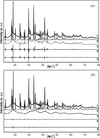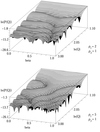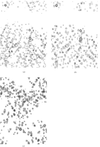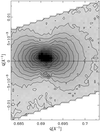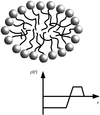issue contents
October 2004 issue

Cover illustration: Volumetric visualization of electron density surrounding a histidine residue, allowing for direct observation of discrete disorder; generated with POVScript+ and rendered with POVRay. Courtesy of T. D. Fenn, D. Ringe & G. A. Petsko [J. Appl. Cryst. (2003), 36, 944-947].
research papers
Pole point plots are generalized to augmented pole point plots visualizing a second crystallographic direction subjected to random orientations. ω sections of the space of crystallographic orientations generalizing both γ as well as σ sections are introduced into texture analysis and shown to visualize an orientation probability density function more instructively.
Download citation


Download citation


The crystal structure of a strontium europium aluminate, Sr0.864Eu0.136Al2O4, with a novel hexagonal form was investigated by a combination of Rietveld analysis and the maximum-entropy method with synchrotron X-ray powder diffraction data. The results suggest that AlO4 tetrahedra in Sr0.864Eu0.136Al2O4 are orientationally disordered.
Multilamellar phases can be identified and characterized by small-angle scattering of X-rays or neutrons. The recently developed generalized indirect Fourier transformation method is extended to determine simultaneously the structure factor and the model-free form factor.
It is shown that anomalous X-ray diffuse scattering can be treated as a hologram providing information on the local environment of the anomalous scatterer.
One of the key obstacles in the progress of certain aspects of solid-state physics is the determination of the nature of irregularities in the atomic network of matter and their correlation with macroscopic properties. In this work, an original structural result is presented, namely the presence of icosahedral clusters in an Al solid solution, as deduced from the analysis of the total Fourier-space image.
A new computer program, DICVOL04, based on the successive dichotomy algorithm for powder diffraction pattern indexing is described. Many tests have revealed a high success rate.
Two assembled germanium crystals, produced for use as neutron monochromators, are characterized by means of neutron and X-ray diffraction. The neutron and synchrotron experimental data (reflectivity profiles and topographs) are compared with calculations based on analytical models and Monte Carlo simulations.
A new method of full-profile refinement is developed on the basis of a derivative difference minimization. The method allows powder diffraction structure analysis independently of the background and may also be applicable in many other areas.
The scattering function for spherical core–shell particles with a Schulz–Flory size distribution is derived. The analytical solution is applied to describe the small-angle scattering from core–shell systems with different particle size, polydispersity and ratio of core to shell radii.
A new transmission X-ray imaging technique using ultra-small-angle X-ray scattering (USAXS) as a contrast mechanism is described. USAXS imaging is complementary to USAXS and can provide quantitative and qualitative three-dimensional information on the sizes, shapes and spatial arrangements of the scattering objects.
Download citation


Download citation


The crystal structure of the Γ form of D-sorbitol [C6H14O6, P21212, Z = 12, Z′ = 3, a = 24.3012 (2), b = 20.5726 (2), c = 4.8672 (1) Å, V = 2433.30 (3) Å3] has been solved ab initio at 293 K from powder synchrotron X-ray diffraction data. A real-space method (Monte-Carlo simulated annealing), followed by Rietveld refinements with geometric soft restraints, has been used.
The paper examines analytically and numerically the influence of a constant strain gradient on the rocking-curve peak location in a Laue-case double-crystal diffractometer.
The convergent-beam method for time-of-flight neutron crystallography using capillary optics can give expected integrated intensity gains of ∼100 for a Bragg peak for samples as small as the focal spot (∼100 µm). The diffracted beam intensities have expected gains greater than 500 for powder samples of similar dimensions.
For accurate crystal structure analysis, a new electric furnace for the measurement of high-resolution (δd/d = 0.03%) synchrotron radiation powder diffraction profiles from materials at high temperatures (up to 1900 K in air) has been designed and fabricated. The electron density distribution of cubic CaTiO3 perovskite at 1674 K indicates a covalent bond between Ti and O atoms.
Several early figures of merit (FOMs) are tested for their ability to speed up ab initio protein phasing. A new combined FOM is proposed.
Interpretation of diffuse scattering of decagonal Al–Ni–Co is presented, based on thermal diffuse scattering and Huang diffuse scattering contributions.
Download citation


Download citation


Temperature-dependent (in the range 100–298 K) changes of the crystal lattices of γ- and ∊-hexanitrohexaazaisowurtzitane have been evaluated from the second-rank thermal expansion tensors. Both lattices undergo anisotropic thermal expansion, that of γ-HNIW being more anisotropic than that of the ∊ phase.
The parameters that can be obtained by indirect Fourier transformation of small-angle scattering data of inhomogeneous ellipsoids are discussed. Application of this method to experimental SAXS and SANS data is described.
Download citation


Download citation


Misfit cobalt oxide phases Ca3Co4O9 and Ca0.82(Cu0.65Co0.35O2) have been reinvestigated by Rietveld structure refinements using neutron and synchrotron diffraction data and new insights are given for these complex structures.
teaching and education
Open  access
access
 access
accessThe program HELIX has been devised as a simple aid to understanding the origin and appearance of fibre diffraction patterns from helical structures.
laboratory notes
A 1 mm vertical-profile X-ray beamstop has been designed to operate in the energy range 6–20 keV. The relationship between the beamstop-to-sample distance and air scatter is discussed with the intent of establishing criteria for optimal beamstop positioning during an experiment.
An X-ray diffuser which causes broadening of the synchrotron beam divergence has been developed and used successfully by inserting an amorphous boron powder plate.
computer program abstracts
To simplify the use of the SHELX programs for phasing and as a teaching tool, a graphical user interface, HKL2MAP has been developed.
books received
Free 

Free 



 journal menu
journal menu


















